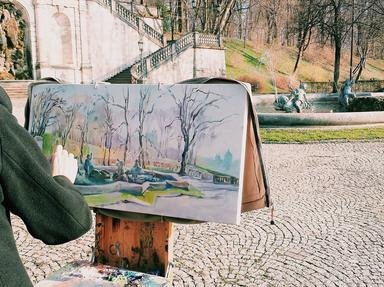Quiz Answer Key and Fun Facts
1. Among the greatest painters of the early Renaissance was the Flemish artist Jan van Eyck. Together with his brother he produced one of the key works of the 15th century, called 'The ______ Altarpiece'. For which city was this triptych produced (and can still be seen)?
2. One of my favorite members of the Impressionist movement is Camille Pissarro, certainly the most underrated painter of that genre. Some of his greatest works feature scenes of the busy boulevards of Paris. An especially lovely painting was executed in 1897 by Pissarro which he entitled 'The Boulevard des __________, Morning, Sunlight' (a very impressionistic title, yes?). Which of these fills the blank?
3. Picasso was a master of many art genres, but he is probably most famous for his involvement in Cubism. Some suggest that his painting 'Les Demoiselles d'_______' was the prototype of the Cubist genre, as it influenced Georges Braque to develop the Analytic Cubist style. In which city were these 'Demoiselles' in Picasso's painting?
4. El Greco was one of the key painters of the late 16th, early 17th centuries, particularly for his Mannerist style works. One of his key paintings was executed in 1586 and called 'The Burial of _________'. Whose name and title fit the blank?
5. Surrealist extraordinaire René Magritte was famous for his reality defying works of art. In one such painting we see a rather large portrait of a smoking pipe with the words 'Ceci n'est pas une pipe' (This is not a pipe) right beneath. The English title of this painting is 'The ________ of Images'. (Fill in the blank)
6. Among my favorite paintings from the 16th century Dutch master Peter Bruegel the Elder is a rather imaginative rendition of a biblical edifice called 'The Tower of _____'. What word fills the blank and completes the title of this 1563 work?
7. Together, Paul Signac and Georges Seurat began a movement that they called 'Divisionism', but that we know better today as 'Pointillism'. One of Seurat's great paintings in this style was his 'Bathers at ________', featuring an idyllic scene at a river bank. Which location completes the title of this sublime art piece?
8. One of my favorite paintings from Sir Joshua Reynolds of the 18th century English school of painters is a delicate portrait of a young girl, dressed in yellow and carrying a basket on her right arm. The painting is called 'The _________ Girl'; what fruit fills the blank (and the basket)?
9. Famous for shocking the world with his 'Ready Made' pieces, Marcel Duchamp also employed his skills as a virtuoso with the brush in creating wonderful semi-abstract paintings such as his '_____ Descending a Staircase'. In this painting, which of these descends down the steps?
10. Édouard Manet played a key role in the formation of the Impressionist movement that developed in the second half of the 19th century. One of his most famous paintings is his '______ on the Grass', which was first exhibited at the Salon des Refuses in 1863. What meal of the day is happening on the grass in this painting?
Source: Author
thejazzkickazz
This quiz was reviewed by our editing team before going online.
Any errors found in FunTrivia content are routinely corrected through our feedback system.
